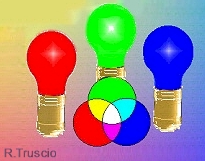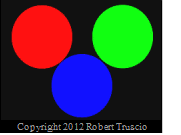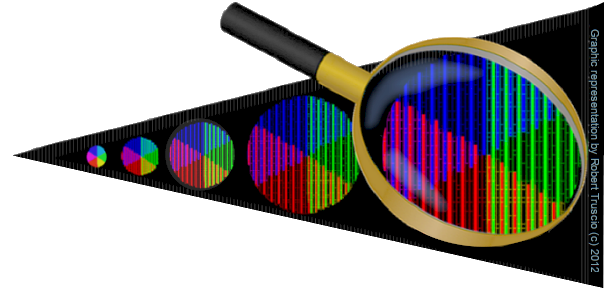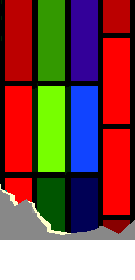|
THE PRIMARY COLORS OF LIGHT
Light has its own set of three primary colors. These are the "additive" primary colors.
The primary colors of light are red, green
and blue. They should not be confused with the three primary
colors used for paints, inks, dyes and other colorants. The
primary colors for light combine in a different way.
 Mixing
color light is called additive color mixing, because adding
light from two or more sources produces the mixed color. The
illumination from two or more colored light sources when added
together will give more illumination than any of the lights by
themselves. Mixing
color light is called additive color mixing, because adding
light from two or more sources produces the mixed color. The
illumination from two or more colored light sources when added
together will give more illumination than any of the lights by
themselves.
This can be seen where the color illumination overlaps. The
yellow formed when red light overlaps green light will be
brighter than either the red light or green light alone.
When
the right amounts of red, green and blue light come together,
the result appears as "white" light.

One of the most common
uses of mixing the primary colors of light is for televisions,
tablets, smart phones and
computer monitor screens.
 |
| These types of screens are made up of rows and rows of
red, green and blue stripes. From
normal viewing distances, the stripes are usually not
noticeable. The human eye causes these stripes that make
up a screen image appear to blend together. Since they blend together in this way, the
stripes
act just as if they are mixing the colors of light together. |
| |
The changing intensity of
each stripe segment allows for all the colors and
shades of a digital image or a television movie to be displayed
on the viewing screen. But if we were to view a screen
image with a powerful magnifying glass, we would see the
ever
changing pixels of red, green and blue that make up
the moving image. |
 |
These technologies use the red blue and
green primary colors of light. What is interesting is that there
is a relationship between the three
primary colors of light and the three primary colors of paints,
inks, dyes and other colorants. Since this website is about both
additive and subtractive color mixing, the following chart shows
this relationship.
ANY TWO
ADDITIVE PRIMARY COLORS
MIX TO MAKE ONE OF THE SUBTRACTIVE PRIMARY COLORS
|
Additive Primary |
+ |
Additive Primary |
= |
Subtractive Primary |
| GREEN |
+ |
BLUE |
= |
CYAN |
|
RED |
+ |
GREEN |
= |
YELLOW |
|
BLUE |
+ |
RED |
= |
MAGENTA |
For more about the
"subtractive" primary colors, select the topic "Subtractive
Color" from the tabs on the top of this page.
|